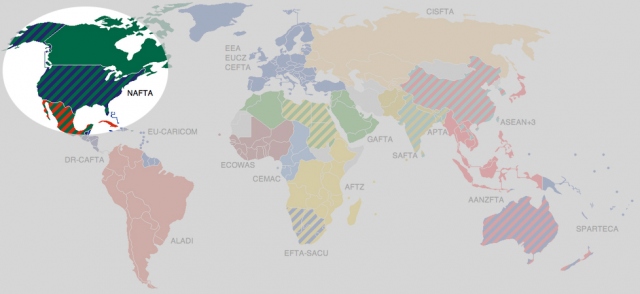
One of the more significant acts that defines the Clinton Administration is the formation of the North American Free Trade Agreement (NAFTA), signed into law in 1993. With origins dating back as far as 1984 with President Reagan's vision of a North American common market, NAFTA was enforced with the purpose of helping increase North America's authority and competitiveness in global trade. While some will argue that long-term results of this agreement between the United States, Canada, and Mexico have proven favorable, NAFTA has brought about a number of challenges in addition to advantages.
With NAFTA, trade between the three North American nations was expected to increase while trading costs decreased. Since its application, trade indeed skyrocketed from an annual average of $3 billion to almost $2 trillion in products and labor. Canada and Mexico in particular enjoyed the benefit of increased exports to the US, while American farmers saw a significant growth in agricultural exports to their neighbors. The absence of tariffs in turn has helped reduce production costs, allowing for NAFTA to create a large area for free trade.
Other benefits of this nearly 20-year-old treaty include:
- Growth in foreign investments. Canada and Mexico have received increases in foreign direct investments, or FDI, totaling in the hundreds of billions. Conversely, the numbers have increased for FDI into the United States from her neighbors.
- Reduced dependency on the Middle East for oil. The absence of tariffs between the NAFTA nations allows the US to import oil from Mexico and Canada, thereby reducing the need to trade with other countries who impose higher costs.
- Growth in service trade. With trade barriers removed, the NAFTA nations may easily offer each other services in health care, finance, and miscellaneous labor.
NAFTA has also caused challenges for its members, each of which has suffered a disadvantage to another's benefit:
- Lost jobs. NAFTA resulted in a number of companies moving production plants to Mexico, where it is cheaper to manufacture items. Naturally, this caused mass unemployment in many cities around the United States. Conversely, Mexican agricultural workers found it difficult to profit with low costs on food exports, forcing many farms to shut down.
- Dubious wage practices. Many claim that companies choosing to remain in the US used NAFTA to bargain with employees to keep them out of unions under threat of shutting down and moving to Mexico. Forced to choose between working and joining a union, workers would choose the former at a personal cost.
Since the application of NAFTA, two side-treaties have been introduced to supplement the trade agreement. The North American Agreement on Environmental Cooperation (NAAEC) was established to aid in environmental health with trade progress, and the North American Agreement on Labor Cooperation (NAALC) helps to improve conditions for all workers. While NAFTA has had many critics over the years, others see the agreement as one of the highlights of the Clinton presidency that still maintains an impact on North American inter-relations. As we face an uncertain economy, the US still retains these ties that could prove beneficial in years to come.